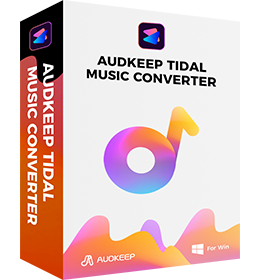Which music streaming service is better: Tidal or Amazon Music? The choices presented to audiences are plenty and selecting the right platform to enjoy high-quality music makes it challenging. Tidal vs Amazon Music provides an insight into the streaming services, with a detailed comparison to help users pick the platform according to their interests.
With many platforms facing controversies and artists pulling their plug, there is a keen interest in Tidal and Amazon Music. Tidal spoiled listeners and audiophiles by offering a Hi-Fi subscription, a service that focuses on sound quality. However, Amazon Music quickly caught up and included the premium service to the already existing paid subscribers.
This article will explore all the essential categories that generally help anyone pick the right platform. We have compared the music library, sound quality, subscription plans, prices, and compatibility between these two music streaming services. Just learn more below.
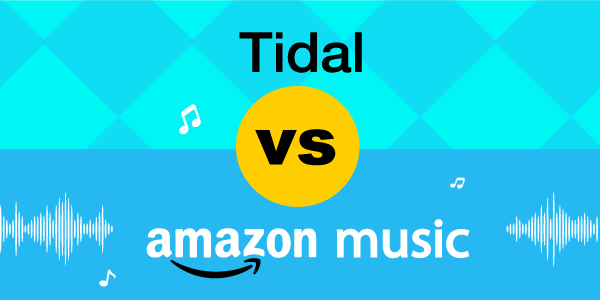
Part 1. What Is Tidal vs What Is Amazon Music
What Is Tidal?
Tidal is a digital music streaming service with over 80 million songs and 350,000 videos. What makes the platform unique is correcting all the music industry’s wrongdoings. For instance, artists receive payment directly for their art, and listeners experience High-Fidelity quality songs.
What Is Amazon Music?
Amazon Music is a music streaming service launched in 2007 by Amazon. The platform gained customers quickly, for it offered downloads without protection from four different labels and independent artists for paid customers. Over the years, it improved the service quality and added several subscription plans.
Yet, Amazon Music vs Tidal provides an insight into the different segments of the platform that many people forget to watch out for when signing up with one. In the following parts, we will illustrate the detail for you.
Part 2. Tidal vs Amazon Music: Music Library
Tidal HiFi vs Amazon Music is difficult to come by because both the entities have an exceptional collection of music, both from profound music producing companies and independent artists.
The music library is the primary asset for any music streaming service provider. In this case, both Amazon Music and Tidal are in the same spot. Amazon Music has more than 70 million songs in its library and is keen on increasing the number by adding independent artists. In addition, the company plans to introduce lossless audio and 3D audio formats by using Dolby Atmos and Sony 360AR. Over seven million songs are available in Ultra-HD or true hi-res audio format.
Similarly, Tidal has 70 million songs and counting. Although the platform sees occasional withdrawal by artists, which is the same for Amazon Music. It is continuing to bring independent artists and others from across the globe from time to time. In addition, Tidal is already offering a HiFi subscription to users, where they get access to hi-res audio or download Tidal HiFi music.
Part 3. Amazon Music vs Tidal Sound Quality
The natural characteristic or the differentiator between both the online music streaming platforms is their ability to stream high-resolution audio without any interruptions. In addition, Amazon Music vs Tidal sound quality speaks about their ability to deliver Hi-Fi audio on any device.
Tidal streams music at 1,411kbps and in FLAC format that protects the original audio quality of the recording and avoids stripping of contents or thereof, which is usually a sight in the MP3 file format. The only way to differentiate the music is by experiencing the audio in both forms. The technological evolution proved what it was capable of and what it could provide in the future.
Amazon Music benefits similarly from the audio upgrade, which now streams most of the content in CD quality. Apart from Dolby and lossless enhancements, subscribers can indulge in pure audio richness by accessing the seven million songs available in Ultra HD with a depth of 24 bits and a sample rate of 192kHz.
Part 4. Tidal vs Amazon Music: Prices and Subscriptions
Audiophiles do not mind paying the extra penny to listen to their favorite collection in high-resolution audio. Tidal HiFi vs Amazon Music in this regard is almost similar, but Tidal does have a plan for everyone. Both the platforms offer discounts to students and military members. The prices and subscriptions for both the music streaming service providers are:
| Monthly Price | Tidal | Amazon Music |
| Free Trial | 30 days | 30 days |
| Standard Plan | $10 | $8 |
| Family Plan | $15 | $15 |
| Student Plan | $5 | $1 |
| Military Plan | $6 | None |
| First Responder Plan | $6 | None |
Both the streaming providers offer the plans monthly and annually. Therefore, depending on the digital music streaming service selection, you can opt for either the monthly or annual package after the trial period. During the trial period, you can check out the quality of the audio and the collection of the songs available. Additionally, you can check for the artists you often listen to or like to find on the digital platform.
Part 5. Tidal vs Amazon Music: Compatibility
Compatibility is of utmost importance for audiences of digital audio streaming. It can be the smartphone app, the web player, or the desktop application. The other stimulating compatibility features include Google Assistant and Amazon Alexa. Amazon Music vs Tidal has attractive compatibility options, which are as follows:
| Tidal | Amazon Music | |
| Android App | Yes | Yes |
| iOS App | Yes | Yes |
| Desktop App (Windows and Mac) | Yes | Yes |
| Web Client | Yes | Yes |
| Alexa Compatible | Yes | Yes |
| Google Assistant Compatible | Yes | Yes |
Part 6. Amazon Music vs Tidal: Offline Playback
Amazon Music streaming quality vs Tidal is a challenging task for many users. However, audiophiles will quickly differentiate between the two. Nonetheless, both platforms deliver exceptional services to audiences and attract more users by adding new tracks, enhancing the audio quality, and adding new subscription plans.
Irrespective of all these, music lovers do love the offline playback feature. Both Tidal and Amazon Music have the option where users can download their favorite tracks to the device. However, it is only possible after a subscription, and the songs stored on the device are playable only through the respective apps. Furthermore, due to the protection of the songs, even if you have a subscription, you are not the owner. Therefore, you cannot listen to the songs offline using a different media player.
Download Tidal Tracks for Offline Listening via AudKeep Tidal Music Converter
A better way to listen to all your Tidal tracks offline without using the application is by using AudKeep Tidal Music Converter. The converter helps you download and convert all the Tidal songs you add to the converter into MP3, FLAC, Lossless, M4A, etc. In addition, you can customize the conversion parameters and set the bit rate and sample rate based on the listening device.
The AudKeep Tidal Music Converter converts at 5x speed without losing original audio quality and retains the ID3 tags for organizing the converted songs. Additionally, you can choose to archive the tracks either by artist or album for quick retrieval.
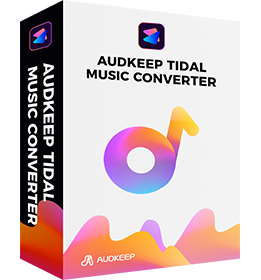
Key Features of AudKeep Tidal Music Converter
- Losslessly download the Tidal music you like at 5X speed
- Keep the downloaded Tidal music with ID3 tags
- Personalize the output settings of music from Tidal, like formats, bitrate, etc.
- Convert and save Tidal songs for offline playback for free
How to Use AudKeep Tidal Music Converter to Convert and Play Tidal Music Offline
Initially, download the trial version of the converter from the AudKeep Tidal Music Converter website. However, note that this version will convert only the first minute of any song added. So, you need to remove this limitation by buying and registering the software.
Step 1 Adjust the output parameters for Tidal songs
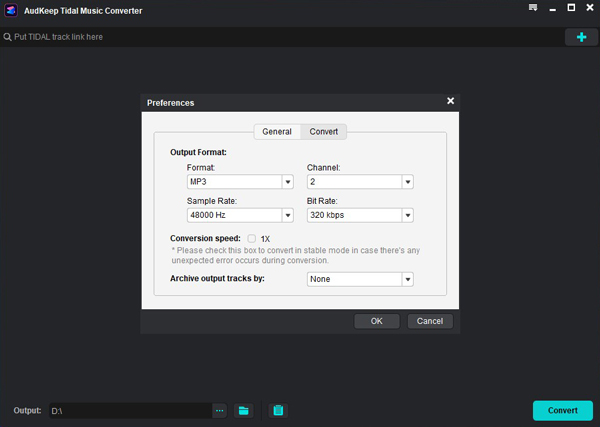
Open the AudKeep converter and click the “Preferences” button from the menu bar. The audio setting window will open, where you must click the “Advanced” tab. Here, you can adjust the format of Tidal to MP3, Lossless, WAV, M4A, FLAC, and AAC. Likewise, you can define the bit rate and sample rate along with the option to archive the tracks by artist or album.
Step 2 Add Tidal music into AudKeep
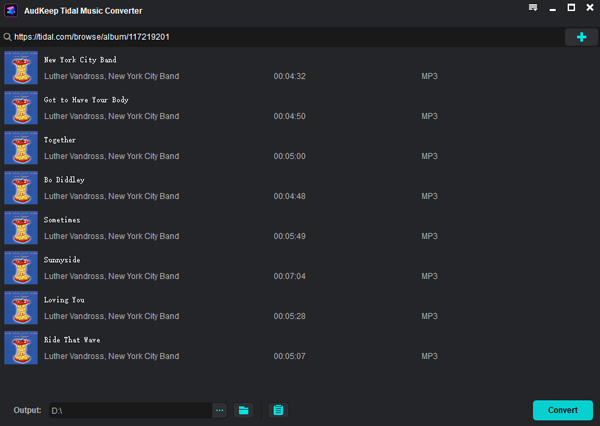
The converter comes with a built-in Tidal web client. Therefore, you can search for your favorite Tidal songs, albums, and playlists from the search bar. Once you have the song or album, highlight them to see a “+” sign. Then click the plus symbol to add the Tidal music tracks to the converter.
Step 3 Convert and download Tidal music for offline use
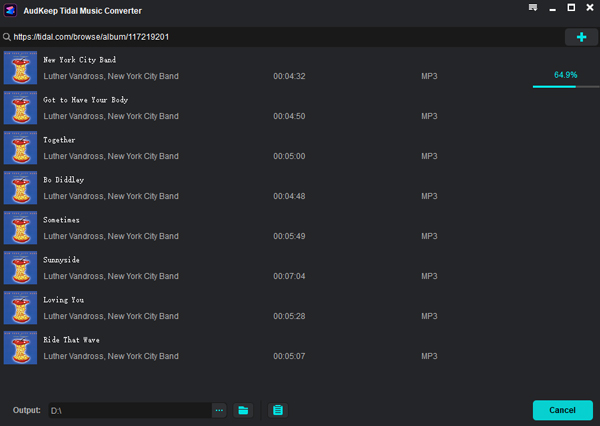
After completing the addition of the tracks, click the “Convert” button to allow AudKeep to download Tidal music to your computer. You can choose 1x, or 5x speeds based on the number of songs you have added to the converter. AudKeep will convert the Tidal songs without losing the ID3 tags. After completing the conversion, click the folder icon to open the folder containing the converted Tidal songs. You can now listen to these songs in high quality without the Internet anytime, and transfer them to a different device for offline listening.
Part 7. Conclusion
Amazon Music vs Tidal provides a detailed insight into the different things one would expect to see before applying for a subscription. The table below shows all the crucial points of the two prominent music streaming services in the world. You can check them out and then decide to choose the music streaming service that suits you.
| Amazon Music | Tidal | |
| Number of Songs | > 70 million | > 70 million |
| HD Audio Quality | HD for up to 850kbps; Ultra HD for up to 3730kbps | HiFi for up to 1411kbps; Master from 2304 – 9216kbps |
| Android App | Yes | Yes |
| iOS App | Yes | Yes |
| Desktop App (Windows and Mac) | Yes | Yes |
| Web Client | Yes | Yes |
| Alexa Compatible | Yes | Yes |
| Google Assistant Compatible | Yes | Yes |
| Music Videos | Yes | Yes |
| Lyrics | Yes | Yes |
| Individual Plan | $8/month | $10/month |
| Student Plan | No | $5/month |
| Military Plan | No | $6/month |
| First Responder Plan | No | $6/month |
| Family Plan | $15/month | $15/month |
